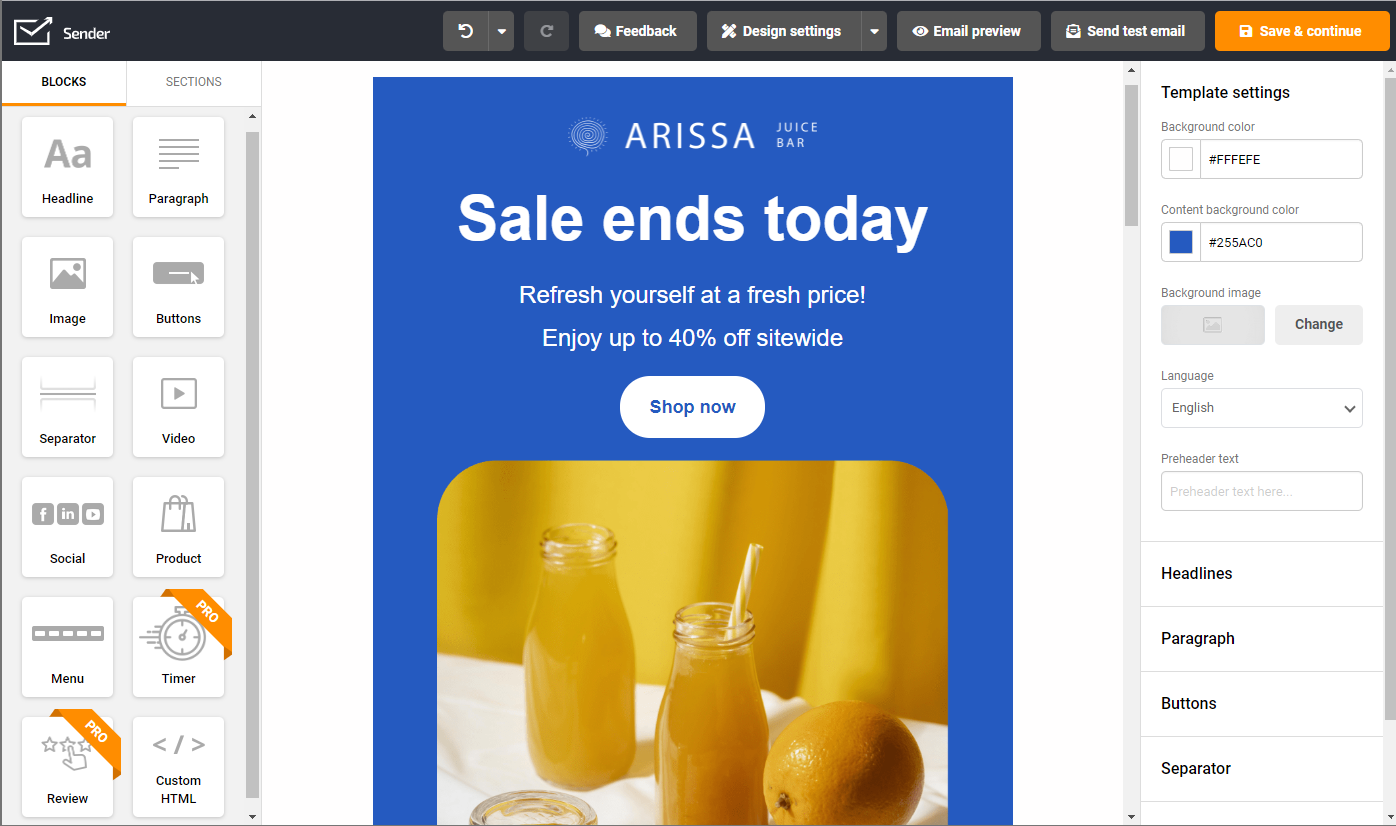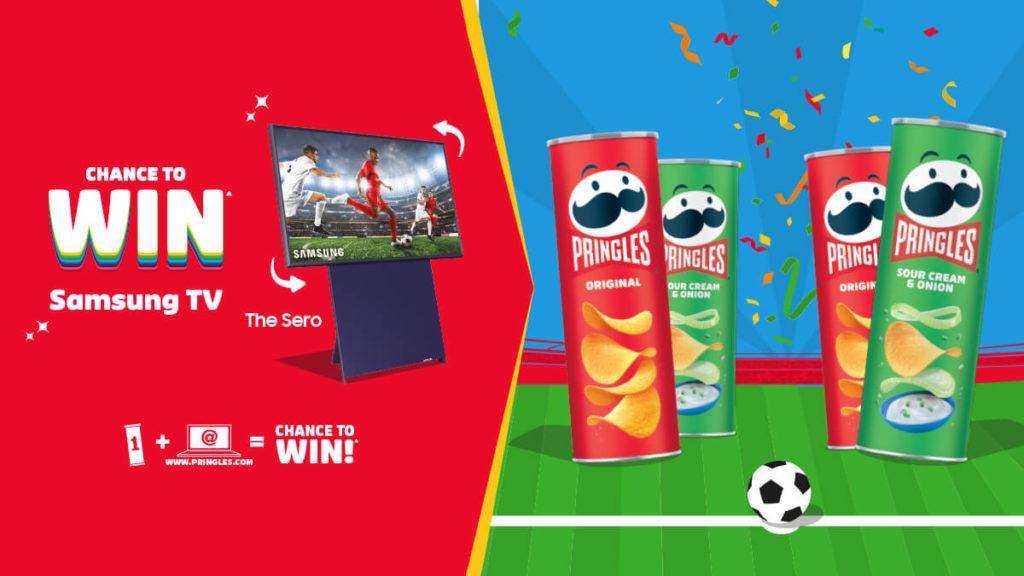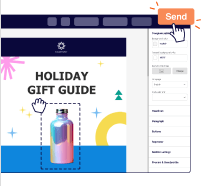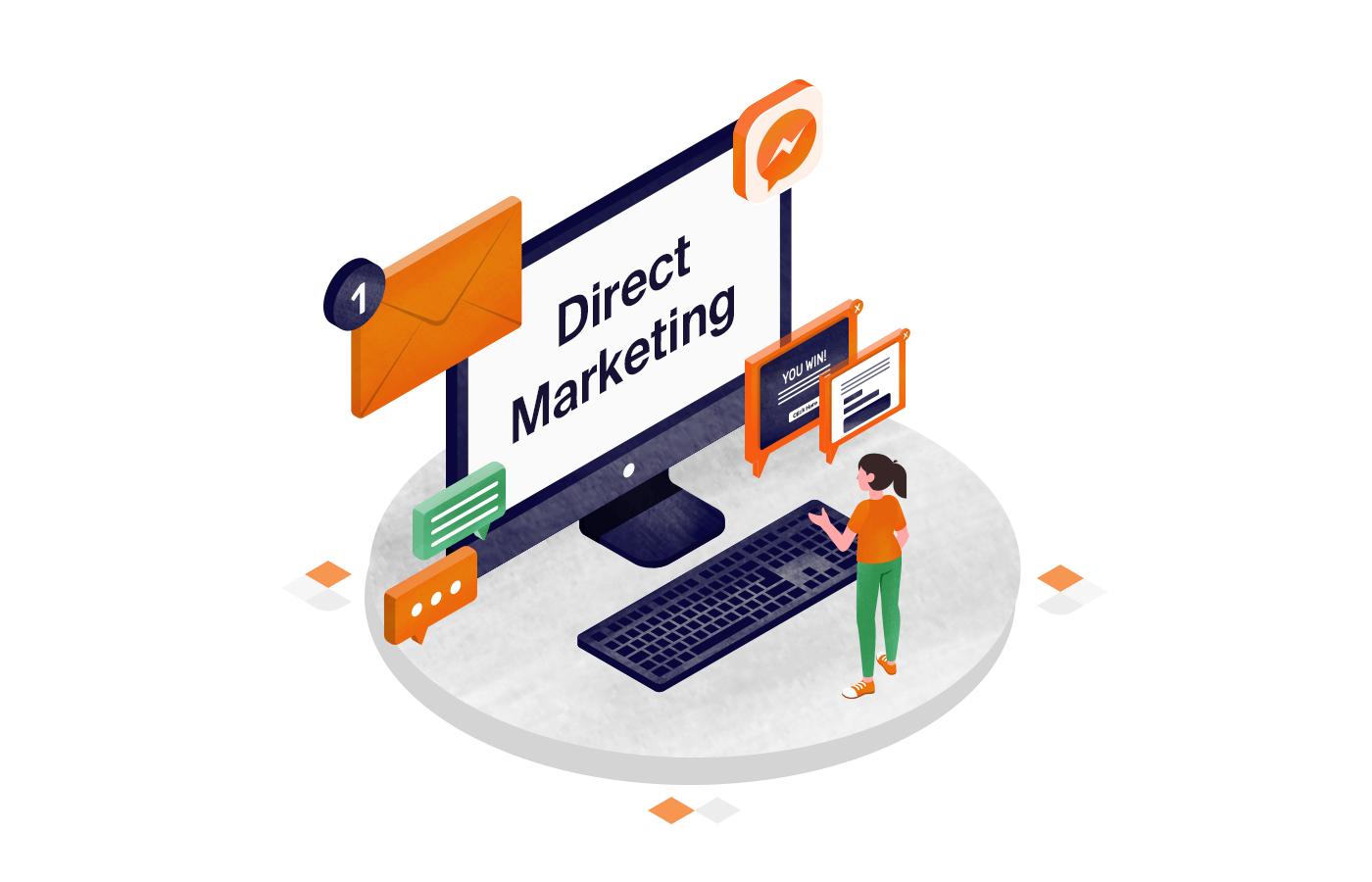Ever feel like you’re wasting efforts trying to attract ideal customers in a competitive market? That’s where direct marketing can help.
Instead of broadcasting your message to everyone, it connects you directly with your ideal customers through email, social media, or even a text.
At Sender, we’ve seen firsthand how a well-crafted direct marketing campaign can cut through the noise, build real connections, and deliver measurable results.
Direct marketing can put your message where it matters most—right in front of your target audience. So, without further ado, let’s see how you can put this strategy to work for your business.
What is Direct Marketing? Definition
Direct marketing is a type of advertising where you deliver marketing messages directly to potential customers, usually through email, direct mail, or telemarketing.
The fundamental principles surrounding direct marketing:
- They’re highly targeted — you’re talking to specific customer segments only per campaign;
- They have strong personalization — because you know who you’re talking to, you can address their objections, nurture and convert them better;
- They’re measurable — you can track and attribute each and every dollar. It helps you understand and summarize the ROI of any marketing efforts.
Features of Direct Marketing
To better understand how direct marketing differs from other forms of marketing, we have to take a closer look at its essential elements:
- Targeting. In direct marketing, marketers can communicate directly and engage their customers using targeted messages;
- Database segmentation. In direct marketing, it’s common practice to segment the customer database according to specific features and send personalized messages to segmented audiences later;
- Response tracking. Being directly involved in marketing performances allows them to evaluate their efficiency effectively. And to optimize marketing campaigns in return.
The Goal of Direct Marketing
The primary goal of direct marketing is simple: inspire immediate action.
Whether it’s encouraging a purchase, signing up for a free trial, or generating leads, direct marketing aims to connect with customers directly and drive measurable results. For direct marketers, success is about clarity and impact.
Here’s what you should aim for:
- Measurable actions. Every campaign should lead to a specific, trackable outcome like clicks, sign-ups, or purchases;
- Personal connection. Your messages should be relevant and form a personal connection;
- Cost-efficiency. Campaigns should bring more value than they cost for a positive ROI;
- Leveraging multiple channels. Channels like email, SMS, and social media should be used simultaneously to diversify reach.
How Does Direct Marketing Work?
Businesses use direct marketing to communicate or send sales pitches to a targeted customer base via email, social media, direct mail, or SMS campaigns.
Direct selling works through well-implemented segmentation and targeting based on recipients’ behavior, demographics, and interests.
To sum up, direct marketing efforts involve:
- Crafting high-converting campaigns;
- Creating highly targeted messages that allow speaking to specific types of audiences;
- Using personalization to nurture leads better and develop great relationships over time;
- Promoting specific products and services or offers more than competitors;
- Getting more sales from existing and potential customers;
- Planning mobile marketing campaigns using responsive emails and social media.
What are Direct Marketing Channels?
Direct response marketing thrives on channels that put your message directly in front of your audience, cutting out middlemen and noise.
Each channel offers unique ways to connect, engage, and convert, whether it’s through email, PPC ads, or social media. Let’s explore how to leverage these effectively.
Email Marketing
Email marketing is the most promising channel for direct marketing, with an ROI of up to 3600%. With targeted campaigns, you can reach your target audience right in their inbox.
The channel is highly personalized, scalable, and very effective in nurturing leads and boosting conversions.
Here are some tips to register high ROI using email marketing:
- Segment your list to tailor content to specific groups;
- Use marketing automation to automate personalized campaigns based on interest or activity;
- Add a clear call-to-action (CTA) to drive clicks and conversions;
- Optimize for mobile devices to ensure readability on the go.
Start your first email marketing campaign—for free! With Sender’s Free Forever plan, you get all the tools you need to create and run successful email campaigns, no strings attached.

Pay-per-Click Advertisement
Ever clicked on that ad at the top of your Google search? That’s PPC in action—helping businesses get noticed when you’re looking for answers.
PPC campaigns let you target users based on their search intent, delivering instant visibility and measurable results.
Here are some tips for utilizing PPC as a direct marketing channel:
- Use long-tail, semantic keywords to attract qualified leads;
- Experiment with A/B testing to refine ad copy and visuals;
- Monitor your quality score to reduce costs and improve ad placement;
- Include a compelling CTA to boost click-through rates (CTR).
Social Media
No matter how distracting social media may feel, we can’t ignore its potential for directly marketing to your ideal customers.
A well-planned social media strategy utilizes personalized ads, relatable content, and interactions to engage and convince audiences to buy.
Here are some quick tips that work:
- Use social ads to target specific demographics and interests;
- Leverage direct messaging for personalized engagement;
- Share user-generated content to build trust and authenticity;
- Track performance metrics to optimize your campaigns over time.
Organic Search Traffic
You’ve probably searched for answers or products online and clicked the first result that caught your eye—that’s the influence of organic search.
Organic search traffic connects users actively searching for solutions with your content, making it a long-term direct marketing channel.
Here’s what you should remember about organic search:
- Focus on SEO-optimized content that answers user queries;
- Use targeted keywords to align with your audience’s search intent;
- Build backlinks to improve your domain authority;
- Monitor analytics to identify opportunities for content improvement.
7 Main Types of Direct Marketing
The type of direct marketing strategy you choose should be relevant to your business and niche. To help you decide which direct channels you should utilize, here are the seven major types:
1. Targeted Email Marketing
While social media remains a viable and cost-effective alternative, email marketing ranks among the most promising direct marketing methods that even the biggest companies on the planet use.
Here’s an email example from Apple:

Here are some ways to create an effective email marketing strategy:
- Choose an email marketing tool that meets your needs. For example, Sender is a powerful email marketing software for ecommerce and SMBs looking for a high-converting, delivery-optimized solution without breaking the bank;
- Every now and then, take a glance at the way your most successful direct competitor is approaching their email marketing campaign. Leverage the hard work they might have already put in; it might help you avoid obvious and glaring mistakes in your niche.
2. Push Notification Marketing
Push notification marketing is sending marketing communications using push messages.
Push messages are clickable popups you can send to a customer’s desktop, browser, or mobile notification center even if the user hasn’t visited your website or opened your app. They’re broadly divided into two categories: mobile notifications and browser notifications.
Here’s an example:

Push notifications can drive customer engagement by encouraging users to open mobile apps on their phones.
With that in mind, here are some push notification best practices you can apply to your marketing campaigns:
- Use the personalization and audience segmentation features to target strategically;
- Use push notifications to remind customers about abandoned shopping carts;
- Add brand icons and images to attract customer attention instantly.
Also read: What is an Email Notification? Definition, Templates
3. Targeted Online Display Ads
Chances are that you’ve already encountered a targeted display ad today. Simply put, targeted display ads are all shapes and sizes of banners (HTML5, video, or static images). They target prospects after various characteristics, including behavior, psychographics, and demographics.
The performance of these types of ads is measured by impression or CPM (Cost Per Mille) and not by how many people clicked on the mobile banner ads.
Here’s an example:

Here are valuable tips for creating banner ads that perform:
- Decide on your objective – lead generation, branding, or increasing sales – and target your audience wherever they are in the marketing funnel. Due to its versatility, online advertising can have an impact at any point in the funnel, so it’s much more effective if you reach out to prospects, leads, and existing customers simultaneously.
- The best formula for a banner that works is one image, a compelling headline, and concise copy. In other words, always stick to the point but consider how to grab attention first.
- If you include several types of mediums in your marketing efforts, remember that if something works for one, it might not work for another. For instance, a one-page print ad will hardly look as nice when remade into a banner.
- To optimize your campaign, you must thoroughly test what works best. Perform A/B testing on all aspects of the banner: copy, image, CTA, and display timing, and then use this knowledge to create upcoming targeted display ads.
Also read: What is Targeted Marketing? Definition, Strategies & Examples
4. Text Message Marketing
Text message marketing uses SMS (Short Message Service) to send marketing and other messages directly to mobile devices. With open rates as high as 98% and response rates as high as 45%, SMS is one of the most affordable ways for businesses to connect with their mobile customers.
You can use text messages for various purposes, including account authentication, reminders, sending coupons and discounts, and notifications about orders.
Here’s an example:

Here are some common direct marketing strategies you can apply to your SMS campaigns:
- Use SMS marketing together with your other customer engagement strategies, such as email and social media marketing and push notifications to boost your marketing campaigns;
- Welcome new opt-ins with sales and promotion offers;
- Test and measure your messaging tactics to improve your SMS campaigns.
Also read: What is an SMS Notification? Definition, Examples
5. Social Media Marketing
Social media marketing uses the power of social media platforms to share information, drive website traffic, increase sales, and build your company’s brand.
You can use social media to build a direct connection with your ideal customers. Your posts, profile, and interactions with followers can help you form an approachable persona that users can connect with and trust. As a result, you can generate leads and conversions directly on these social platforms.
For example, BuzzFeed’s Tasty videos on Facebook are cooking shows that are typically less than two minutes long. These videos provide on-trend recipes to their highly-engaged audience.
Here’s an example:

Here’s how to create a successful social media strategy:
- Know your audience and what platforms they use, who else they’re following, and what type of marketing materials they like;
- Focus on adding value to users through helpful content, which will help you promote your brand organically;
- Measure your social media activity for quantifiable insights to inform your strategy.
6. Direct Mail Marketing
Direct mail marketing is a type of marketing businesses use to deliver messages physically to customers’ mailboxes through the U.S. Postal Service or another delivery service. Common examples include flyers, catalogs, and postcards. The digital equivalent is email marketing.
Nowadays, the majority of marketing is done digitally. However, when done well, direct mail marketing can complement your other channels to build customer relationships and help your business stand out.
Here are some ways to create effective direct marketing campaigns:
- Define your audience to determine who your product is best suited for, then focus your marketing efforts on them;
- Ensure you have a call-to-action (CTA) to direct customers on what to do after receiving your mail;
- Monitor how many prospects respond to your direct mail, then follow up with them later.
Also read: What is Online Advertising? Definition, Benefits & Examples
7. Telemarketing
Telemarketing is a marketing technique where businesses sell their services or products over the phone. Traditionally, it was done primarily over the phone. However, these days, brands also use videoconferencing, particularly in the later stages of the buying process.
Here are some best practices to help you utilize telephone calls for direct marketing:
- Define and understand the prospects you intend to contact. Did they enter a trade show prize drawing or open an email about your product?
- Have complete knowledge of your products and be able to overcome objections during phone calls.
- Listen to customers to build a customer relationship rather than closing the sale.
Direct vs. Indirect Marketing – Key Differences
In direct marketing, you ask prospects and potential customers to buy your product or service proactively. Examples of direct marketing channels include print media ads, email marketing campaigns, telemarketing, and more.
In contrast, indirect marketing is a form of marketing where you build awareness and visibility around your business, which translates into business growth over time. Common indirect marketing channels include SEO-optimized blog posts, referrals, and online reviews.
| Direct Marketing | Indirect Marketing |
| Targets a specific audience or customer base | Targets a broad audience |
| Involves direct communication with customers, such as through mail, email, or telemarketing | Involves advertising through outdoor advertising, TV ads, radio, or newspapers and magazine ads |
| Focuses on generating an immediate response and action from customers | Focuses on building brand awareness and creating a long-term impression |
| Typically utilizes a database of customer information to personalize messages and offers | Relies on market research and analytics to understand the audience and create campaigns |
| Can be more cost-effective as it targets a specific audience and encourages immediate action | Can be more expensive as it aims to reach a larger audience and build brand recognition |
| Offers the ability to track and measure the success of campaigns through metrics such as response rate and conversion rate | Can be more difficult to measure the success of campaigns as they may not result in immediate action from customers |
Both direct and indirect marketing concepts hold meaning for a business as part of an overarching digital marketing strategy.
Key Takeaways
- Direct marketing is a targeted advertising approach that delivers marketing messages directly to potential customers through email, direct mail, telemarketing, and door-to-door visits;
- Direct marketing campaigns have strong personalization, target specific customer segments, and are measurable;
- Direct marketing is more cost-effective, generates immediate action from customers, and is highly measurable compared to indirect marketing;
- The type of direct marketing strategy you choose should be relevant to your business and niche, and it’s important to monitor the response rates and follow up with prospects.
Find more relevant information to lead your way in marketing:

